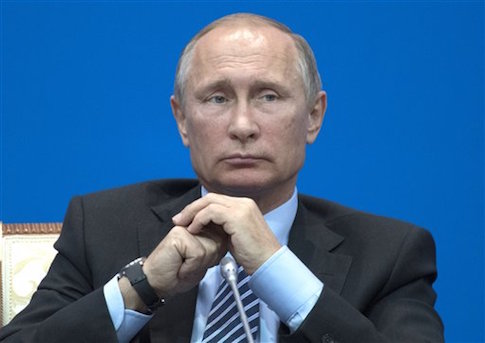Russia increased its deployed nuclear warheads over the past six months under a strategic arms reduction treaty as U.S. nuclear warhead stocks declined sharply, according to the State Department.
During the same period, the United States cut its deployed nuclear warheads by 114, increasing the disparity between the two nuclear powers.
Russia’s warhead increases since 2011 suggest Moscow does not intend to cut its nuclear forces and will abandon the New START arms accord as part of a major nuclear buildup.
"It is now highly unlikely that Russia intends to comply with New START," said Mark Schneider, a former Pentagon nuclear weapons specialist now with the National Institute for Policy.
At the same time, the Obama administration is continuing a program of unilateral nuclear disarmament despite promises by President Obama to modernize and maintain U.S. nuclear forces as long as strategic dangers are present.
The latest Russian warhead increases coincide with increased tensions between Moscow and the West.
The nuclear buildup is raising new fears Russia plans to break out of New START treaty limits rather than comply with the accord. Russian forces have deployed 249 warheads above the warhead limit set by the treaty to be reached by February 2018.
Since the treaty went into force in 2011, Moscow increased its total warhead stockpile from 1,537 warheads to 1,796 warheads, an increase of 259 warheads.
By contrast, the Obama administration has cut U.S. nuclear forces by 433 warheads during the same period.
Air Force Gen. John E. Hyten, nominee to be the next commander of the U.S. Strategic Command, warned the Senate during a hearing last month that Russia is modernizing both its strategic and tactical nuclear weapons.
"It seems clear that Russia has been making large investments in its nuclear weapon programs as well as modernizing both its strategic and non-strategic nuclear weapons," Hyten stated in answers to questions posed by the Senate Armed Services Committee.
"In addition to advancing nuclear capabilities, Russia is emphasizing new regional and strategic approaches, and declaring and demonstrating its ability to escalate if required," he added. "Collectively, Russian development of advancing weapons capabilities and its evolving warfighting doctrine is concerning."
Under New START, the United States and Russia agreed to reduce deployed nuclear warheads to 1,550 warheads. Deployed land-based and submarine-launched missiles and bombers will be cut to 700. Missile launchers and non-deployed heavy bombers will be reduced to 800.
While U.S. nuclear forces are very old and in need of modernization, Russian nuclear forces are being modernized. By 2020, nuclear missile submarines, land-based missiles, and bombers will be modernized, with 70 percent of the nuclear forces replaced with advanced systems, according to U.S. officials.
In a related development, Russia announced on Tuesday it is abandoning a 2000 agreement to reduce stockpiles of plutonium originally intended for nuclear weapons.
"We’re disappointed with their decision," Pentagon spokesman Peter Cook said of the Russian rejection of the plutonium agreement.
The Russian action followed the State Department’s decision to cut off talks with Russia on Syria.
Schneider, the nuclear weapons expert, said Moscow appears to be on a path to doubling its warheads.
"With or without New START, Russian deployed strategic nuclear warheads are likely to increase to 3,000 by 2030," he said.
Other troubling signs of Russian nuclear weapons advances include intelligence reports that Moscow is expanding underground nuclear command bunkers, violating New START terms, and planning to double its warhead stockpiles for new multiple-warhead missiles.
Schneider added that the sharp U.S. nuclear cuts indicate the Obama administration is moving ahead with a unilateral disarmament scheme.
"I think it is also clear that the Obama administration has an unannounced program to implement Obama’s proposed one-third reduction in strategic nuclear forces from the New START level unilaterally," he said.
A strategic military balance that existed in 2011 when the treaty was approved has now been reversed by Russian increases and U.S. cuts.
"In 2011, the United States had a lead of 263 deployed warheads," Schneider said. "We are now 429 deployed warheads below Russia. The Russians will think this is quite important. It could impact Putin’s willingness to take risks."
Russia has adopted a new nuclear strategy that lowers the threshold for the use of nuclear arms in a conflict. Moscow calls the nuclear doctrine, escalate to de-escalate.
Blake Narendra, spokesman for the State Department’s arms control bureau, dismissed the Russian warhead increase, saying it was part of a "business-like" implementation of the treaty provisions.
"The United States and Russia continue to implement the New START treaty in a business-like manner," Narendra said. "The treaty does not prescribe interim limits. We fully expect Russia to meet the treaty's central limits by February 2018."
Narendra said current tensions with Russia highlight the need to abide by treaty provisions on verification and confidence-building measures.
Without the treaty, the United States would lack information about Russian strategic forces that are currently being modernized, he said.
"Fluctuations in the number of deployed warheads is an expected process as the Russians replace older missiles dating from the 1980s that are being retired and eliminated," Narendra said.
Hans M. Kristensen, an analyst with the Federation of American Scientists, a group that favors nuclear arms cuts, said he believes the Russians will continue to abide by the treaty despite the 259 warheads it has deployed over New START levels.
"Rather than a nuclear build-up, however, the increase is a temporary fluctuation caused by introduction of new types of launchers that will be followed by retirement of older launchers before 2018," Kristensen said, adding "Russia’s compliance with the treaty is not in doubt."
Regarding other New START provisions, Russia had reduced its deployed strategic delivery systems—land-based and submarine missiles and bombers—slightly from 521 systems to 508 systems. The United States cut its missile and bomber forces by 60 systems over the same six-month period.
Russia cut its deployed and non-deployed delivery systems, another New START category, by 18 launchers and bombers. The United States cut 30 systems over the same period.
